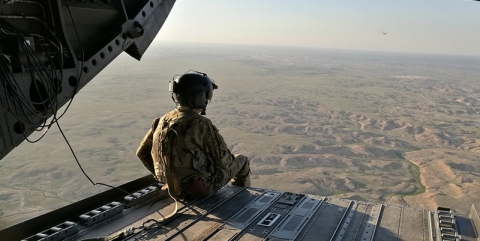

18 February 2021
3 min read
Debris from depleted uranium munitions used in the Gulf War has long been blamed for contributing to the illness of hundreds of thousands of veterans, but new research proves it is not the cause.
More than a quarter of a million US, UK and other Allied nations’ servicemen and women have endured Gulf War Illness since the Persian Gulf War in 1991, 30 years ago.
The illness has a range of acute and chronic symptoms, including fatigue, headaches, joint pain, indigestion, insomnia, dizziness, respiratory disorders and memory problems, and appears rooted in neurological impairment.
It has long been plausibly alleged that the soldiers inhaled significant quantities of depleted uranium from allied munitions used on the battlefield and suffered from its toxic and mildly radioactive effects.
For decades, medics and scientists have been looking for the elusive cause of Gulf War illness.
Professor Randall Parrish, Research Professor of Isotope Geology, University of Portsmouth
Research at the University of Portsmouth tested US Gulf War illness sufferers to examine levels of residual depleted uranium in their bodies and their study proves conclusively – and, for many, surprisingly – that none of them were exposed to any significant amounts of depleted uranium.
The testing took into account the predicted decline in depleted uranium from normal metabolism over the time since potential exposure and testing, by using a highly sensitive method of testing in conjunction with metabolic modelling.
The research, by Professor Randall Parrish at the University of Portsmouth, UK, and Dr Robert Haley, of the University of Texas Southwestern Medical Centre in Dallas (USA), is published in Nature Scientific Reports.
Professor Parrish said: “For decades, medics and scientists have been looking for the elusive cause of Gulf War Illness.
“That depleted uranium is not and never was in the bodies of those who are ill at sufficient quantities to cause disease will surprise many, including sufferers who have, for 30 years, suspected depleted uranium may have contributed to their illness.”
He and Dr Haley believe the most likely remaining causes for the illness are low-level and widespread exposure to sarin nerve agent released widely from the destruction of Iraqi chemical weapons caches in January 1991, possibly compounded by the use of organophosphate anti-nerve agent medication and the liberal use of pesticides to prevent malaria exposure to allied forces.
Professor Parrish said: “Depleted uranium munitions were used in the conflict as an effective weapon to destroy Iraqi tanks and its use has littered Iraq and Kuwait with uranium contamination, potentially affecting local people.
“Medical studies have shown that it can cause cancers and birth defects and for decades it has been alleged to be a smoking gun in Gulf War illness, which affects about a quarter of the 700,000+ allied forces who served in the six-month conflict.
“The plausibility of the link between depleted uranium and the illness has bubbled along now for nearly 30 years, but we would argue it’s time to look elsewhere.”
Professor Parrish developed a method of detecting depleted uranium in urine from an exposure many years earlier and tested it on a widely studied representative cohort of 154 well- monitored US Gulf War veterans who have the illness.
Not a single trace of depleted uranium was found in any of the samples.
The Allies’ own activities destroying an Iraqi nerve agent cache or spraying pesticides liberally on troops could be seen in hindsight as an inadvertent ‘own goal’.
Professor Randall Parrish, Research Professor of Isotope Geology
This test was developed at and applied to veterans’ urine samples using high sensitivity mass spectrometry at the University of Portsmouth, a method that is at least 10 times more sensitive and robust than all the other previous measurements.
Professor Parrish said: “Uranium in urine samples is extremely low in concentration, so just doing the analysis is very challenging; in effect I had to extract and purify less than a tenth of one billionth of a gram of uranium from 150 grams of a urine sample containing about 5 grams of organic goo dissolved in it.
“We worked out how to do this without losing any of the uranium while also removing all the junk we don't want. That's about the same magnitude of task as extracting pure gold from seawater.”
Having found no depleted uranium in any of those with the illness, and no difference between them and a control group, who weren’t on the battlefield, alongside knowing how long the substance remains in the body and can be traced in the urine, proves depleted uranium is not linked to Gulf War illness.
Professor Parrish said: “Being able to debunk the alleged connection between this illness and this radioactive substance allows the medical community to focus more clearly on what the likely cause(s) actually are.
“Finding causes is a nebulous game when you have so many options to blame. The Allies’ own activities destroying an Iraqi nerve agent cache or spraying pesticides liberally on troops could be seen in hindsight as an inadvertent ‘own goal’ and one to be avoided in future conflicts. It is important to find causes for conditions like this, even if it takes a long time and the causes might be controversial.”
